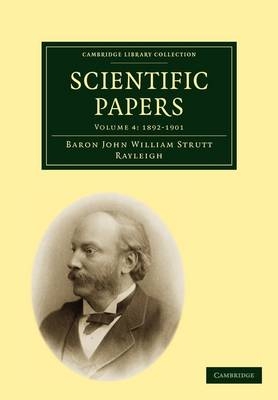
Scientific Papers
Seiten
2009
Cambridge University Press (Verlag)
978-1-108-00545-6 (ISBN)
Cambridge University Press (Verlag)
978-1-108-00545-6 (ISBN)
Nobel Laureate Lord Rayleigh was justifiably renowned for the clarity and quality of his work, which has had a continuing impact. This fourth of six chronological volumes of his most important scientific papers covers 1892–1901, including his discovery of argon and the first articulation of the Rayleigh–Jeans Law.
This volume of Lord Rayleigh's collected papers begins with a brief 1892 piece in which the author addresses the troubling discrepancies between the apparent density of nitrogen derived from different sources. Intrigued by this anomaly and by earlier observations by Cavendish, Rayleigh investigated whether it might be due to a previously undiscovered atmospheric constituent. This led to Rayleigh's discovery of the chemically inert element, argon, to his 1904 Nobel Prize in physics, and to the discovery of all the 'rare' gases. Debate over the nature of Roentgen rays, is reflected in a short 1898 paper, written in the wake of their discovery. 1900 saw a key contribution, the elegant description of the distribution of longer wavelengths in blackbody radiation. Now known as the Rayleigh–Jeans' Law, this complemented Wien's equation describing the shorter wavelengths. Planck's law combined these, in a crucial step toward the eventual development of quantum mechanics.
This volume of Lord Rayleigh's collected papers begins with a brief 1892 piece in which the author addresses the troubling discrepancies between the apparent density of nitrogen derived from different sources. Intrigued by this anomaly and by earlier observations by Cavendish, Rayleigh investigated whether it might be due to a previously undiscovered atmospheric constituent. This led to Rayleigh's discovery of the chemically inert element, argon, to his 1904 Nobel Prize in physics, and to the discovery of all the 'rare' gases. Debate over the nature of Roentgen rays, is reflected in a short 1898 paper, written in the wake of their discovery. 1900 saw a key contribution, the elegant description of the distribution of longer wavelengths in blackbody radiation. Now known as the Rayleigh–Jeans' Law, this complemented Wien's equation describing the shorter wavelengths. Planck's law combined these, in a crucial step toward the eventual development of quantum mechanics.
Preface; Scientific papers 197–272; classified table of contents of vols. 1–4; Index.
| Erscheint lt. Verlag | 20.7.2009 |
|---|---|
| Reihe/Serie | Scientific Papers 6 Volume Paperback Set ; Volume 4 |
| Zusatzinfo | Worked examples or Exercises |
| Verlagsort | Cambridge |
| Sprache | englisch |
| Maße | 32 x 244 mm |
| Gewicht | 990 g |
| Themenwelt | Naturwissenschaften ► Physik / Astronomie ► Atom- / Kern- / Molekularphysik |
| ISBN-10 | 1-108-00545-4 / 1108005454 |
| ISBN-13 | 978-1-108-00545-6 / 9781108005456 |
| Zustand | Neuware |
| Haben Sie eine Frage zum Produkt? |
Mehr entdecken
aus dem Bereich
aus dem Bereich
Buch | Softcover (2024)
Wiley-VCH (Verlag)
CHF 83,85


